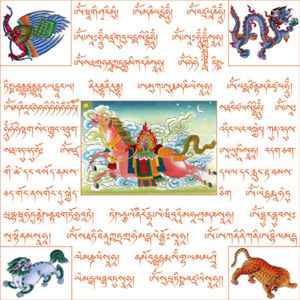Prayer flags: Difference between revisions
Jump to navigation
Jump to search
No edit summary |
No edit summary |
||
| (12 intermediate revisions by 3 users not shown) | |||
| Line 1: | Line 1: | ||
[[Image: | [[Image:lungta flag SG cal.jpg|thumb|300px|The flag of lungta (windhorse)]] | ||
'''Prayer flags''' | '''Prayer flags''' (Tib. དར་ལྕོག, ''dar cho'', [[Wyl.]] ''dar lcog'') are displayed in the Tibetan Buddhist tradition to generate [[merit]] and increase one's life force. | ||
Prayer flags are inscribed with auspicious symbols, invocations, prayers, and | Prayer flags are inscribed with auspicious symbols, invocations, prayers, and [[mantra]]s. Some flags bear [[dharmapala|protectors]] and enlightened beings. Sets of five colour flags are displayed in the colours: yellow, green, red, white, blue. These colours represent the elements: earth, water, fire, wind, space. | ||
===Windhorse prayer flags=== | ===Windhorse prayer flags=== | ||
The windhorse prayer flags typically display a [[tiger]], a [[snow lion]], a [[garuda]], and a [[dragon]], (the [[four dignities]]) with a [[windhorse]] in the | The windhorse prayer flags typically display a [[tiger]], a [[snow lion]], a [[garuda]], and a [[dragon]], (the [[four dignities]]) with a [[windhorse]] in the centre around which is written the mantra, "May the horse of good fortune run fast and increase the power of life, influence, fortune, wealth, health, and so forth." | ||
power of life, influence, fortune, wealth, health, and so forth." | |||
[[Category: | [[Category:Iconography]] | ||
Latest revision as of 00:45, 18 June 2018

Prayer flags (Tib. དར་ལྕོག, dar cho, Wyl. dar lcog) are displayed in the Tibetan Buddhist tradition to generate merit and increase one's life force.
Prayer flags are inscribed with auspicious symbols, invocations, prayers, and mantras. Some flags bear protectors and enlightened beings. Sets of five colour flags are displayed in the colours: yellow, green, red, white, blue. These colours represent the elements: earth, water, fire, wind, space.
Windhorse prayer flags
The windhorse prayer flags typically display a tiger, a snow lion, a garuda, and a dragon, (the four dignities) with a windhorse in the centre around which is written the mantra, "May the horse of good fortune run fast and increase the power of life, influence, fortune, wealth, health, and so forth."